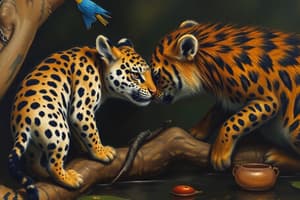Podcast
Questions and Answers
What is the name of the blue ant in the story?
What is the name of the blue ant in the story?
Alcon
How does the blue ant establish a symbiotic relationship with the red ant society?
How does the blue ant establish a symbiotic relationship with the red ant society?
By providing them with a sweet substance in return for protection.
What is the impact of the sweet substances produced by the queen beetles on the behavior of ants?
What is the impact of the sweet substances produced by the queen beetles on the behavior of ants?
It can make them more passive or more aggressive to protect the queen beetles.
How do blue ants sometimes put themselves in danger even inside well-protected nests?
How do blue ants sometimes put themselves in danger even inside well-protected nests?
What happens when the queen beetles die?
What happens when the queen beetles die?
How does the blue ant larva synchronize its movements during the journey to the hidden fortress?
How does the blue ant larva synchronize its movements during the journey to the hidden fortress?
What is the name of the larval ant species that targets red ants?
What is the name of the larval ant species that targets red ants?
How long can some queen beetles live inside the same nest?
How long can some queen beetles live inside the same nest?
What do some ants do to protect young queen beetles from predators?
What do some ants do to protect young queen beetles from predators?
How can the sweet substances produced by queen beetles affect ant behavior?
How can the sweet substances produced by queen beetles affect ant behavior?
What do young larval ants sometimes do to queen beetles inside the nests?
What do young larval ants sometimes do to queen beetles inside the nests?
How can small environmental changes affect the behavior of the ants?
How can small environmental changes affect the behavior of the ants?
Flashcards are hidden until you start studying
Study Notes
- Shimaa Nabil is a blue ant named Alcon, living an unusual life in a red ant colony.
- The ant, named Gaith Takrity, allows the blue ant to live despite its difference, as it is the offspring of some of the colony's queen's brood.
- The blue ant lays an egg and it hatches into a larva, which after some days begins the dangerous journey to a hidden fortress.
- The larva crawls while synchronizing its movements with the queen's hourglass-shaped ant hill search.
- During its journey, it encounters a red ant worker, which it interacts with using sensitive chemicals to identify the ant.
- The blue ant is not able to find the castle easily, but the red ant queen takes care of it as one of her brood's sick ants.
- The blue ant grows and, with time, develops a symbiotic relationship with the red ant society, providing them with a sweet substance in return for their protection.
- The relationship between the blue and red ants is complex, with some blue ants protecting the young queen beetles from predators and consuming the sweet secretions they produce.
- The mixture of sweet substances produced by the queen beetles can have a significant impact on the behavior of ants, either making them more passive or more aggressive to protect the queen beetles.
- The blue ant's unusual lifestyle puts it in danger, as even inside well-protected nests, they sometimes prey on queen beetles and lay eggs on their bodies.
- When the queen beetles die, the blue ants consume them.
- Alcon blue is one of approximately 200 types of larval ants that target red ants.
- In some cases, multiple queen beetles live in the same nest at the same time, with some of them living for up to two years.
- Researchers continue to study the complex relationship between the ants, and some ants protect young queen beetles from predators and consume the sweet secretions they produce.
- The materials in the sweet substances can affect ant behavior, either slowing them down or making them more aggressive to protect the queen beetles.
- Despite the complex and intricate relationship between the ants, they remain a threat to each other.
- Inside their well-guarded nests, young larval ants sometimes prey on queen beetles and lay eggs on their bodies.
- When the queen beetles die, the blue ants consume them.
- The complex behavior of these ants, which includes plants and specific ant species, can be affected by small environmental changes.
- One species of larval ants, which lived in the United Kingdom during the 1970s, disappeared and was later reintroduced after several years of effort to restore the ecosystem for the ant-feeding species.
Studying That Suits You
Use AI to generate personalized quizzes and flashcards to suit your learning preferences.




